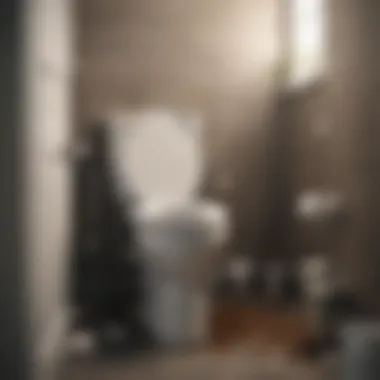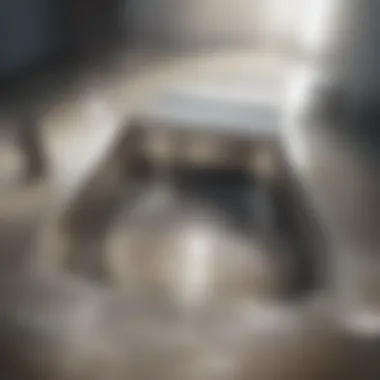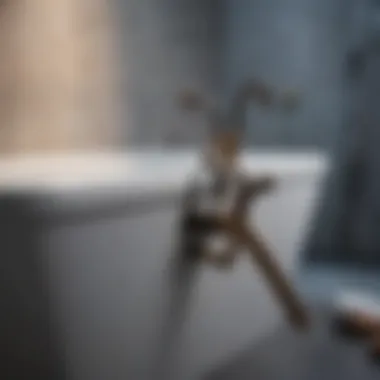Understanding and Resolving Backed-Up Toilets and Bathtubs


Intro
Backed-up toilets and bathtubs represent a common but pressing issue for homeowners. Not only do they cause inconvenience, but they can also indicate deeper plumbing problems that may lead to costly repairs if not addressed promptly. Understanding the root causes, identifying warning signs, and knowing how to respond can save time, money, and stress. This article aims to demystify the reasons behind these plumbing challenges and provide actionable solutions.
Highlighting Key Points
The discussion will cover various aspects of toilet and bathtub backups, including:
- Common causes of backups, such as clogs and plumbing design flaws.
- Warning signs that indicate a potential backup situation.
- Troubleshooting methods to address minor issues before they escalate.
- Preventative measures to avoid future plumbing problems.
- Guidance on when to consult with plumbing professionals.
Each of these points will be explored in detail to equip homeowners with the knowledge they need to maintain their plumbing systems effectively. Let's delve into the critical elements that contribute to these common household problems.
Prelims to Plumbing Backups
Understanding plumbing backups is essential for any homeowner or tenant. Backed-up toilets and bathtubs represent not only an inconvenience but also a serious concern that can escalate into more significant issues if left unaddressed. Awareness of plumbing functionality aids in recognizing problems early. This discussion serves to elucidate the importance of being proactive about potential plumbing problems and highlights the benefits of grasping the essentials of home drainage systems.
Defining Backup Issues in Plumbing
Backup issues in plumbing can manifest in several ways. The most common signs include slow drainage, gurgling sounds, or unpleasant odors. A backup occurs when waste or debris obstructs the flow of water in pipes. This blockage can lead to serious plumbing complications, including flooding or sewage backup, which can damage flooring and walls. Identifying these issues early can mitigate damage and reduce costly repairs.
Plumbing backups often vary in severity. Minor blockages may fix with simple tools, while more serious situations might require professional intervention. Factors contributing to backups range from accumulated debris to issues with the drainage system.
Importance of Understanding Toilet and Bathtub Functionality
Grasping how toilets and bathtubs function helps homeowners manage their plumbing effectively. Toilets operate through a system of valves, bowls, and traps that need to work harmoniously. The bathtub, too, relies on proper drainage to maintain efficiency. Understanding these frameworks provides insight into potential weak points in the system.
Moreover, knowing how each fixture operates can prevent misuse that may lead to backups. For instance, flushing items intended for the trash can cause blockages. Recognizing what can and should not enter these systems is crucial.
Additionally, this knowledge expands into general plumbing practices that can save significant time and money. Homeowners who are well-informed about their plumbing systems are better equipped to take precautionary measures, thus preventing setbacks before they arise.
Common Causes of Backed-Up Toilets and Bathtubs
Understanding the common causes of backed-up toilets and bathtubs is essential for effective home maintenance. Knowing what leads to these issues can help homeowners and renters prevent plumbing disasters, saving both time and money. The causes can vary from simple misunderstandings about what should or shouldn’t be flushed or poured down drains, to more complicated issues related to the infrastructure of the plumbing system itself. This section aims to outline these causes and provide clarity on how they contribute to backups, facilitating more informed decision-making in home maintenance and repairs.
Clogs from Debris and Materials
One of the leading causes of backed-up toilets and bathtubs is clogs caused by debris and materials. Common items include excess toilet paper, hygiene products, hair, and food remnants. These substances can accumulate over time, restricting water flow within the pipes.
It's crucial to be mindful about what is allowed to enter the drainage system. Many homeowners underestimate the impact of even small items. For example, flushing items labeled as "flushable" may not break down adequately.
Regular maintenance can help manage these clogs. One effective approach is to use a drain strainer, especially in bathtubs, to catch hair and larger particles. Additionally, periodic inspections can identify buildup before it becomes a significant problem. Preventing clogs at the source is less costly than dealing with the aftermath of a backup.
Issues with Drainage Systems
Drainage systems are designed to efficiently carry wastewater away from the home. However, issues within these systems can create significant problems. Common issues include improper slope, blockages, and aging infrastructure.
If the drainage system is not installed with the correct slope, water flow can become sluggish, leading to backups. Even small issues, like a slight bend in the pipe, can lead to serious slowdowns. Blockages can also form due to buildup of grease or objects caught in the pipes.
Homeowners should consider regular maintenance on their drainage systems. Cleaning the drains can prevent major issues and ensure smooth operation. If persistent problems occur, it might indicate a more severe underlying issue that requires professional examination.
Tree Root Intrusion
Tree roots may seem an unlikely cause of plumbing problems, yet they are quite common. As trees grow, their roots search for water, sometimes infiltrating sewer lines. This intrusion can lead to blockages and severe damage.
Such intrusions are often not visible, making detection challenging for homeowners. Symptoms might include slow drainage or unusual gurgling noises from the toilet. If tree roots are suspected, a professional inspection is usually needed to assess damage and determine solutions, which might include root removal or replacement of damaged pipes.


"Tree roots often infiltrate pipes at the joints, causing substantial backups. Regular inspections can help mitigate this risk."
In summary, understanding these common causes lays the groundwork for effective plumbing maintenance. Awareness can lead to preventative measures, reducing the likelihood of dealing with backed-up toilets and bathtubs.
Identifying Warning Signs of Backups
Identifying warning signs of backups in toilets and bathtubs is crucial for homeowners and real estate enthusiasts. Recognizing these signs early can prevent major plumbing issues that may lead to costly repairs. Each symptom can reveal different underlying problems. This section details the primary indicators of impending backups, emphasizing the need for vigilance in home maintenance.
Slow Drainage of Water
One of the most common warning signs is slow drainage in toilets or bathtubs. When you notice that water takes unusually long to empty, this often signifies a clog or an obstruction in the drain. Over time, minor clogs can worsen, leading to complete stoppages. Regularly checking the drainage speed can help you catch these issues early. If multiple fixtures are draining slowly, this may point to a more significant blockage in the main sewer line.
Unpleasant Odors
Unpleasant odors coming from the bathroom or nearby areas should not be ignored. These smells can be indicative of a blockage or an accumulation of waste and bacteria in the pipes. Foul odors may signal that stagnant water is present, a situation that can lead to further plumbing complications. Ensuring your bathroom is well-ventilated and routinely checking for bad smells can help you identify issues before they escalate.
Gurgling Noises
Gurgling noises when flushing the toilet or draining a bathtub should raise immediate concerns. These sounds usually occur when air pockets are trapped in the drain due to a blockage. This can cause pressure changes within the plumbing. If you hear gurgling noises consistently, it may be a sign that a clog is forming. Prompt action can be crucial in preventing a more severe plumbing disaster.
Pay attention to these warning signs to ensure your home remains in good condition. Early intervention can save you both time and money.
In summary, being aware of the early signs of backups can help mitigate potential problems. Slow drainage, unpleasant odors, and gurgling noises are three main indicators homeowners should monitor closely. Addressing these symptoms early on can keep your plumbing system functioning smoothly and protect your property value.
Initial Steps to Take When Backups Occur
Addressing a backup in toilets and bathtubs is crucial to maintaining a functional and hygienic home. When faced with a plumbing backup, the first few actions can greatly influence the overall outcome. Understanding these initial steps can help homeowners effectively manage the situation, minimizing stress and potential damage.
Assessing the Situation
The first step in dealing with a backup is to understand the severity of the issue. Take a moment to inspect the situation thoroughly. Look for visible signs of overflow or pooling water around both the toilet and bathtub. Check whether other fixtures in the bathroom are experiencing similar issues. Are sinks draining slowly, or is there a gurgling sound? These indications can help you pinpoint if the problem is localized or part of a larger plumbing issue.
Consider the following points during your assessment:
- Check for Blockages: Look for items that may have fallen into the toilet or bathtub, causing a blockage. Common culprits include large amounts of toilet paper, hygiene products, or foreign objects.
- Verify Water Levels: Observe the water levels in the toilet bowl and bathtub. Rising water levels are a strong indicator of a blockage that requires immediate attention.
- Listen to Sounds: A gurgling noise can suggest that air is trapped in the drainage system, hinting at a potential blockage. Pay attention to any unusual sounds that may be coming from the plumbing.
This assessment allows you to determine whether immediate action is required or if it is safe to continue using other plumbing fixtures.
Preventing Further Damage
Once you have evaluated the situation, the next priority is to prevent further damage. Quick action at this stage can save homeowners from expensive repairs or exacerbated issues. Here are key strategies to follow:
- Stop Usage: Temporarily halt using the affected bathroom until the issue is resolved. This minimizes the risk of overflowing and damaging your home.
- Turn Off Water Supply: If the backup is severe, consider turning off the water supply to the affected fixtures. This can help prevent potential flooding.
- Contain Spills: Place towels or buckets around the area to catch any potential overflow. This simple step can prevent water from affecting flooring or surrounding areas.
- Avoid Chemical Cleaners: Initially refrain from using chemical drain cleaners, as these might not only be ineffective for certain blockages but may also cause additional problems within the plumbing.
The actions taken right after a backup can critically alter the repair process and costs associated with plumbing issues. Being proactive can save trouble down the road.
DIY Solutions for Minor Backups
Addressing minor backups in toilets and bathtubs is essential for homeowners wanting to maintain functionality and avoid larger plumbing issues. DIY solutions are often straightforward and can save both time and money. Engaging in these tasks can prevent a simple issue from becoming a bigger, costly problem. However, it is important to approach these solutions with a clear strategy. A correct understanding of the tools and methods involved is crucial for effective results.
Using a Plunger Effectively
One of the first tools you should consider is the plunger. This basic yet powerful instrument can tackle many minor clogs. It works by creating suction to dislodge debris blocking the pipes.
When using a plunger, it’s critical to choose the right type. A flange plunger, which has an extended rubber flap, is best for toilets. For bathtubs, a cup plunger is suitable.


Steps to use a plunger:
- Ensure there is enough water in the bowl or tub. Without adequate water, the plunger cannot create enough pressure.
- Position the plunger over the drain, making sure it entirely covers it.
- Press down gently to remove air, then use firm up-and-down motions. Repeat this several times.
- Check to see if water drains effectively. If not, continue plunging.
Effective plunging can resolve clogs without the need for more invasive techniques.
Employing Plumbing Snakes
If plunging does not yield results, a plumbing snake can be your next resort. This tool is designed to navigate deeper into pipes, removing trapped debris. It's particularly useful for clogs located far from the drains.
Using a plumbing snake involves these steps:
- Insert the snake into the drain until you feel resistance.
- Crank the handle to push the snake beyond the blockage.
- If you feel the blockage break free, continue to extend the snake to ensure complete removal.
- Slowly pull the snake out, allowing any additional debris to follow.
- Run hot water to test if the drain flows smoothly.
Using a plumbing snake can often resolve stubborn clogs effectively, making it a valuable tool in your maintenance arsenal.
Chemical Drain Cleaners
Another option to address minor backups is chemical drain cleaners. They contain strong substances designed to dissolve organic matter causing blockages. While effective, it is important to use them judiciously. The harsh chemicals can sometimes damage pipes, especially older ones.
When using chemical cleaners, consider the following guidelines:
- Read the product instructions carefully.
- Ensure proper ventilation in the area to avoid inhaling fumes.
- Allow the solution to sit in the drain for the recommended time, typically 15 to 30 minutes.
- Follow up by flushing the drain with hot water.
While chemical drain cleaners can be helpful, they should not be your first line of defense. They are more effective for occasional use rather than regular maintenance.
When to Seek Professional Help
Addressing plumbing backups promptly is vital for maintaining a healthy and functional home. While some minor issues can be handled with DIY approaches, there are instances where seeking professional help is not just advisable but essential. Recognizing the right moment to bring in experts can prevent further damage and save on costly repairs in the long run. In this section, we will explore the signs indicating that professional intervention is necessary, as well as how to choose the right professionals for your plumbing needs.
Recognizing Severe Issues
Homeowners should be vigilant about the signs that indicate a severe plumbing problem. Here are some key indicators:
- Persistent Water Backup: If water continuously backs up despite multiple attempts to clear it, this might indicate a deeper blockage or system failure.
- Multiple Fixtures Affected: When both the toilet and bathtub are backing up simultaneously, it often points to a systemic issue within the drainage system rather than an isolated clog.
- Overflowing Fixtures: An overflow from either the toilet or bathtub can quickly escalate into a major disaster. Immediate action is required to prevent extensive water damage.
- Significant Odors: Strong smells can indicate sewage backup, which poses health risks and should be dealt with by a professional.
- Fluctuating Water Levels: If the water levels fluctuate in different parts of the house, this can suggest a serious issue with the plumbing system.
If any of these signs are present, it is critical to consult a plumbing professional.
Choosing the Right Professionals
Selecting the correct experts to handle plumbing issues can be daunting. Here are some considerations:
- Licensing and Insurance: Ensure that the plumber is licensed and insured. This protects you from liability in case of accidents during repairs.
- Experience: Look for professionals with considerable experience, especially with issues similar to yours. A seasoned plumber is more likely to diagnose and fix problems efficiently.
- Reviews and Recommendations: Seek recommendations from friends or read online reviews. A solid reputation often correlates with quality work.
- Cost Estimates: Always get a written estimate before work begins. This will help avoid unexpected expenses and ensure transparency.
- Emergency Services: Consider whether the plumber offers emergency services. Plumbing issues often require immediate attention, especially if they pose risks to health or property.
Bringing in professionals should not be viewed as a failure but as an investment in the long-term health and safety of your home.
"In plumbing, as in many aspects of maintenance, waiting too long can lead to much larger problems and higher costs."
By recognizing the signs of severe plumbing issues and knowing how to choose qualified professionals, homeowners can take proactive steps to safeguard their homes from significant plumbing disasters.
Preventative Measures to Avoid Backups
Preventing backups in toilets and bathtubs is crucial for maintaining a functional and hygienic home. Understanding these preventative measures can save homeowners significant time and money. Regular attention to plumbing systems enhances their longevity and reduces the chances of costly emergencies.
Routine Maintenance Practices


Routine maintenance is the foundation of an effective preventative strategy. This involves regular checks and cleaning of drainage systems. Homeowners should routinely inspect toilets and bathtubs for signs of wear or buildup.
- Flushing Practices: Flushing the toilet only with appropriate materials is vital. Avoid flushing items like paper towels, feminine products, or excessive toilet paper.
- Drain Cleaning: Utilize baking soda and vinegar as natural cleaners. Pour half a cup of baking soda down the drain, followed by half a cup of vinegar. Let it sit for 30 minutes before flushing it with hot water. This helps prevent buildup.
- Strainers: Installing strainers in bathtubs and sinks captures hair and debris, preventing them from obstructing pipes. These should be cleaned regularly.
By incorporating these simple yet effective practices into the weekly household routine, residents can minimize the risk of clogs significantly.
Educating Household Members
Education is an equally important element in preventing backups. Every member of a household should understand how to care for plumbing fixtures. This minimizes potential issues right from the source.
- Awareness Campaign: Hold a brief family meeting to explain what should and should not be flushed. Make it clear that toilets are not trash cans.
- Signs of Trouble: Teach family members to recognize signs of a backup, such as unusual noises from toilets or slow drainage in bathtubs. Prompt reporting can lead to quicker action.
- Involvement in Maintenance: Encourage all household members to participate in routine drain cleaning tasks. This builds awareness and responsibility.
When everyone understands their role in maintaining plumbing, the likelihood of backups decreases. This collaborative approach fosters a sense of care for the home environment and supports the overall functionality of plumbing systems.
"Prevention is easier than repair. Regular maintenance ensures that your plumbing systems remain in optimal condition."
By adopting preventative measures, homeowners can help protect their plumbing systems, ensuring a comfortable and functioning living space.
Impact of Backups on Home Design
Understanding the impact of backups on home design is crucial for homeowners, designers, and real estate professionals. Backed-up toilets and bathtubs can lead to significant inconveniences and costly repairs. Not only do these issues affect the functionality of a space, but they also influence aesthetic choices and property value. This connection between plumbing issues and home design highlights the need for careful planning and consideration during renovations or new constructions.
Considerations in Bathroom Layout
When designing a bathroom, layout considerations are essential to avoid plumbing issues in the future. A well-thought-out design can minimize the risk of backups. Here are several factors to consider:
- Proper Drain Placement: Ensuring that all drains are appropriately positioned can help maintain a smooth flow of waste.
- Slope of the Floor: The floor should have a slight slope towards the drain to facilitate drainage and prevent water pooling.
- Accessibility: A layout that allows easy access to plumbing fixtures will aid in maintenance and repairs.
In addition, incorporating adequate spacing between fixtures can prevent overcrowding, which often leads to clogs.
Choosing Durable Materials
Selecting durable materials is another pivotal aspect that impacts a home’s design and its resilience to plumbing issues. Materials that are resistant to water damage will contribute to the longevity of the bathroom. Consider these materials:
- Porcelain or Ceramic Tiles: These are not only aesthetically pleasing but also resistant to moisture, making them ideal for bathrooms.
- Waterproof Paints: Using specialized paints helps safeguard walls against moisture and mold growth.
- Quality Plumbing Fixtures: Investing in high-quality fixtures can reduce the risk of leaks and backups, thus preserving the integrity of the design.
Choosing the right materials can influence not just the look but also the functionality and durability of the space.
In summary, understanding how backups can affect home design enables informed decisions during construction or renovations. Careful planning concerning layout and material choice can significantly reduce the risk of plumbing issues, resulting in a more functional and appealing living environment.
Endings and Key Takeaways
In wrapping up our exploration into the realm of backed-up toilets and bathtubs, it becomes clear that understanding the underlying issues is fundamental for every homeowner. The consequences of neglecting plumbing troubles can escalate quickly, leading to more extensive damages and costly repairs. Therefore, the significance of this topic extends beyond mere inconvenience; it is pivotal for maintaining a functional and comfortable living space.
Recap of Common Causes and Solutions
Various common causes can lead to backups in plumbing systems.
- Debris and materials: Items like hair, soap scum, and foreign objects often obstruct either toilets or bathtubs, disrupting the normal flow of water.
- Drainage issues: Problems within the drainage systems, such as improper installation or blockages in pipes, can also lead to backups.
- Tree root intrusion: Roots from nearby trees can infiltrate sewer lines, creating severe blockages that require expert attention.
To tackle these issues effectively, homeowners can employ several solutions:
- Regular maintenance: Engaging in routine inspections and cleanings can prevent clogs before they start.
- Effective use of plunger and plumbing snakes: These tools can remedy many minor blockages without the need for chemicals or professional assistance.
- Promptly addressing warnings: Recognizing early symptoms, like slow drainage or unpleasant odors, can avert more serious plumbing issues.
Final Thoughts on Plumbing Maintenance
Preventative maintenance cannot be overstated. It serves not just to tackle imminent problems but also to educate homeowners about the intricacies of their plumbing systems. Understanding how toilets and bathtubs function helps in appreciating their complexities and avoiding mishaps. Simple yet effective habits, like not flushing anything besides waste and toilet paper or ensuring hair is caught in a trap, can extend the longevity of plumbing fixtures.
"Staying informed about your home’s plumbing means staying ahead of potential problems."
By synthesizing the knowledge gained from this article and applying it, homeowners will be better prepared to maintain an efficient and functional plumbing system.







